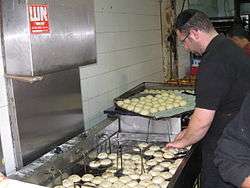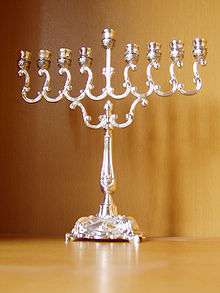Sufganiyah
|
Classic Hanukkah sufganiyot | |
| Type | Jelly doughnut |
|---|---|
| Place of origin | Israel |
| Main ingredients | Dough, jelly or custard, powdered sugar |
Sufganiyah (Hebrew: סופגנייה or סופגניה [ˌsuf.ɡan.iˈah]; plural: sufganiyot, Hebrew: סופגניות [ˌsuf.ɡan.iˈot]; Arabic: سوفغنية) is a round jelly doughnut eaten in Israel and around the world on the Jewish festival of Hanukkah. The doughnut is deep-fried, filled with jam or custard, and then topped with powdered sugar.[1] At Hanukkah, Jews observe the custom of eating fried foods in commemoration of the miracle associated with the Temple oil.
Etymology
The Hebrew word sufganiyah derives from the word for sponge (sfog, Hebrew: ספוג;[2] isfanj, Arabic: إسْفَنْج).[3] Sfenj, a Maghrebi doughnut, comes from the same root.
A popular Israeli folktale holds that the word "sufganiyah" comes from sof-gan-yud-hey ("סוף גן 'ה"), meaning "the end of the Garden of the Lord"[4] (the Garden of Eden). According to the legend, when Adam and Eve were thrown out of the Garden by the Lord, He cheered them up by feeding them sufganiyot. No known commentator on the Tanakh supports this interpretation.[5]
History
The tradition of eating deep-fried pastries on Hanukkah was considered ancient even in the time of the 12th-century rabbi Maimonides, whose father, Rabbi Maimon ben Yosef, wrote that "one must not make light of the custom of eating sofganim [fried fritters] on Chanukah . It is a custom of the Kadmonim [the ancient ones].” These sofganim were likely syrup-soaked fried cakes, akin to modern zalabiya in the Arab world.[5]
Description

The ponchke-style sufganiyah was originally made from two circles of dough surrounding a jelly filling, stuck together and fried in one piece.[1] Although this method is still practiced, an easier technique commonly used today is to deep-fry whole balls of dough, and then inject them with a filling through a baker's syringe (or a special industrial machine).[5]
Modern-day sufganiyot in Israel are filled with plain red jelly (usually strawberry), and cost about $0.30 each.[6] However, more expensive versions (priced at up to $3 per sufganiyah) can be stuffed with dulce de leche, chocolate cream, vanilla cream, cappuccino,[7] or even araq, and topped with various extravagant toppings, from coconut shavings and tiny vials of liquor to meringue and fruit pastes.[8] In 2014 one Jerusalem bakery produced sufganiyah dough saturated with Van Gogh Vodka.[9]
Bakeries and grocery stores build excitement for the approaching holiday by selling sufganiyot individually and by the box; they have become a favorite for school and office parties. Angel Bakeries, the largest bakery in Israel, reportedly fries up more than 25,000 sufganiyot every day during the eight-day Hanukkah festival. Each batch uses 100 kilograms of dough and makes 1,600 sufganiyot.[10] Local newspapers add to the excitement by sending out food critics each year to rate the "best sufganiyah in town."
Israeli bakeries began downsizing sufganiyot to appeal to health-conscious consumers in 2016, following an anti-junk food campaign by Health Minister Yaakov Litzman.[11] The usual 100 grams (3.5 oz) size, packing 400 to 600 calories (1,700 to 2,500 kJ),[7] now appears in 50 grams (1.8 oz) size with different fillings and toppings, earning the name "mini."[12]
Varieties
Savory sufganiyot, though rare, do exist. Versions include:
- Panzerotti in Italy, filled with mozzarella and tomato sauce.[6]
- Lachmazikas in Spain, filled with everything from lamb and mushrooms to whitefish, ricotta, peppers, and herbs.[6]
- Sambusa-inspired savory sufganiyot, filled with lentils and peas, are popular among Iraqi Jews in Israel.[6]
- "SufganiKing," sold by Burger King in Israel for Hanukkah 2016: a hamburger, complete with lettuce, tomato, pickles, and ketchup, inside an enormous sufganiyah, though this "sufganiyah" was merely unfilled, sweetened puff pastry. The "SufganiKing" sold for NIS 14.90 ($3.87).[11]
Sufganiyot and sfenj
Before the 1920s, sufganiyot and sfenj, a light, spongy ring of dough fried in oil that is eaten plain, sprinkled with sugar, or soaked in honey, were of comparable popularity in Israel. Sfenj, introduced to Mandatory Palestine by Moroccan Jews, became a widely popular Hanukkah treat because it is easy to prepare at home. However, sfenj's ease of preparation contributed to its loss of popularity. During the late 1920s, the Histadrut, Israel's national labor union, pushed to make the similar jelly-filled sufganiyot the traditional food of Hanukkah. Making sufganiyot well can only be done by professional bakers, and the Histadrut wanted sufganiyot to supplant sfenj in order to secure jobs for Jewish bakers.[5]
Their effort was successful: by 2016, Israel's 7 million Jews were eating 20 million sufganiyot per year, while few Israelis of non-Moroccan origin eat sfenj.[13] More Israeli Jews report eating sufganiyot for Hanukkah than fasting for Yom Kippur.[5][14]
Gallery
 Chocolate and vanilla cream-filled sufganiyot
Chocolate and vanilla cream-filled sufganiyot Elegantly-styled "mini" sufganiyot
Elegantly-styled "mini" sufganiyot Gourmet sufganiyot made by the Roladin bakery chain
Gourmet sufganiyot made by the Roladin bakery chain
See also
References
- 1 2 Roden, Claudia (1996). The Book of Jewish Food: An Odyssey from Samarkand to New York. New York: Alfred A. Knopf.
- ↑ The New Even Shoshan Dictionary. II. p. 932.
- ↑ "تعريف و معنى سفنج في قاموس المعجم الوسيط ،اللغة العربية المعاصر. قاموس عربي عربي". المعاني. Retrieved 2 June 2018.
- ↑ The yud-hey forms the beginning of the Tetragrammaton, yud-hey-vav-hey (יהוה).
- 1 2 3 4 5 Green Ungar, Carol (Winter 2012). "The 'Hole' Truth About Sufganiyot". Jewish Action. Orthodox Union. Retrieved 2018-05-31.
- 1 2 3 4 Kessler, Dana (December 20, 2016). "Savory Sufganiyot Offer a Different Taste of Hanukkah". Tablet. Nextbook. Retrieved June 2, 2018.
- 1 2 Minsberg, Tali & Lidman, Melanie (2009-12-10). "Love Me Dough". The Jerusalem Post. Retrieved 2009-12-17.
- ↑ Maimon, Rotem (1 December 2015). "דירוג "הארץ": מצעד הסופגניות הטובות והגרועות של השנה" [Haaretz Rating: The best and worst sufganiyot of the year]. Haaretz (in Hebrew). Retrieved 27 December 2015.
- ↑ City Mouse Online (24 November 2013). "Rolling in Dough: The 8 Best Hanukkah Sufganiyot in Israel". Haaretz. Retrieved 27 December 2015.
- ↑ Mietkiewicz, Mark (2003-12-20). "Sufganiyot". Food-Lists.com. Retrieved 2010-04-06.
- 1 2 Kamisher, Eliyahu (December 26, 2016). "THE SUFGANIKING DETHRONED". The Jerusalem Post. Retrieved 2 June 2018.
- ↑ Yefet, Orna (2006-12-04). "Hanukkah: Doughnuts go healthy". Ynetnews. Retrieved 2010-04-06.
- ↑ Solomonov, Michael (December 1, 2016). "Why Sfenj Couldn't Be the Official Dessert of Hanukkah". Food52. Missing or empty
|url=(help);|access-date=requires|url=(help) - ↑ Nachshoni, Kobi (September 13, 2013). "Poll: 73% of Israelis fast on Yom Kippur". Ynetnews. Retrieved 31 May 2018.
External links
| Wikimedia Commons has media related to Sufganiyah. |
- Making non-traditional sufganiyot: a demonstration video with Phyllis Glazer
- Sufganiyot – The Best (Heb.)
- The best Hanukkah sufganiyot in Israel
